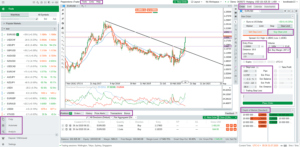Introduction
Pepperstone is a leading online brokerage firm that offers a wide range of trading instruments and services to traders worldwide. One of the key factors that traders consider when choosing an online brokerage is the spread, which is the difference between the buy and sell price of an instrument. In this article, we’ll take a closer look at Pepperstone spreads, including what they are, the different types of spreads offered, and the factors that affect them.
What are Pepperstone spreads?
Pepperstone spreads are the difference between the buying and selling price of a particular instrument in online trading. The spread is expressed in pips, which is the smallest unit of price movement for a particular currency pair. In other words, the spread represents the cost of trading a particular instrument and is a crucial factor for traders to consider when evaluating an online brokerage firm.
Spreads are an important consideration for traders, as they impact the overall cost of trading and can affect profitability. The smaller the spread, the lower the cost of trading, making it more cost-effective for traders. Pepperstone offers competitive spreads, providing traders with access to a wide range of instruments at favorable trading conditions.
It’s important to note that spreads can be affected by various factors, including market conditions, trading volume, and volatility. Traders should consider these factors when evaluating the spreads offered by Pepperstone and determining which brokerage is best for their individual needs.
Types of Pepperstone spreads
Pepperstone offers two types of spreads to traders: fixed spreads and variable spreads.
- Fixed spreads: Fixed spreads are set at a specific level and do not change, regardless of market conditions. This type of spread offers a predictable trading environment, as the spread remains constant and traders can easily calculate their potential profits and losses.
- Variable spreads: Variable spreads, on the other hand, change in real-time based on market conditions. This type of spread can be either wider or tighter depending on market volatility, and can offer more favorable trading conditions during periods of low market volatility. However, variable spreads also carry a higher level of risk, as the spread may widen during periods of high market volatility.
Each type of spread offered by Pepperstone has its own advantages and disadvantages, and it’s important to consider your individual trading style and goals when choosing between fixed and variable spreads. Traders who prefer a predictable trading environment may prefer fixed spreads, while those who are comfortable with market volatility may prefer variable spreads.
Factors affecting Pepperstone spreads
- Market conditions The state of the market, including economic indicators and geopolitical events, can have a significant impact on spreads. Market volatility, for example, can cause spreads to widen, while a stable market can result in tighter spreads.
- Trading volume The volume of trades being executed in the market can impact spreads. Higher trading volume can lead to tighter spreads, while lower trading volume may result in wider spreads.
- Liquidity The liquidity of a particular instrument can also affect spreads. Instruments with high liquidity, such as major currency pairs, tend to have tighter spreads, while those with low liquidity may have wider spreads.
- Volatility Volatility refers to the fluctuation in the price of an instrument. During periods of high volatility, Pepperstone spreads may widen as the market becomes more uncertain. Conversely, during periods of low volatility, spreads may narrow as the market becomes more stable.
- Time of day Spreads may fluctuate based on the time of day, with spreads often being wider during low liquidity periods, such as weekends and overnight.
- Bank holidays Bank holidays in major financial centers can also impact spreads, as the market may be less liquid during these periods.
- Market makers The role of market makers in setting spreads can also impact the spread offered by Pepperstone. Market makers may adjust spreads based on market conditions and their own risk management strategies.
- Competition The level of competition among online brokerages can also affect Pepperstone spreads. Brokerages may adjust their spreads to remain competitive, leading to fluctuations in the spread offered by Pepperstone.
- Brokerage policies Pepperstone’s own policies and strategies, such as their risk management strategies, can also impact spreads.
- Trading style Finally, the trading style of individual traders can also impact spreads. For example, traders who use high frequency trading strategies may see wider spreads, as their trades can have a significant impact on market liquidity.
It’s important to consider these factors when evaluating Pepperstone spreads and determining which brokerage is best for your individual trading needs. By understanding the factors that affect spreads, you can make an informed decision and choose the right brokerage for you.
Comparison of Pepperstone spreads to other online brokerages
When comparing Pepperstone spreads to those offered by other online brokerages, it’s important to consider several factors, including:
- Market conditions: The state of the market, including economic indicators and geopolitical events, can impact spreads. Brokerages may adjust their spreads based on market conditions, so it’s important to consider this when comparing spreads.
- Trading volume: The volume of trades being executed in the market can impact spreads. Higher trading volume can lead to tighter spreads, while lower trading volume may result in wider spreads.
- Liquidity: The liquidity of a particular instrument can also affect spreads. Instruments with high liquidity, such as major currency pairs, tend to have tighter spreads, while those with low liquidity may have wider spreads.
- Volatility: Volatility refers to the fluctuation in the price of an instrument. During periods of high volatility, spreads may widen as the market becomes more uncertain. Conversely, during periods of low volatility, spreads may narrow as the market becomes more stable.
- Competition: The level of competition among online brokerages can also impact spreads. Brokerages may adjust their spreads to remain competitive, leading to fluctuations in the spread offered by Pepperstone.
- Brokerage policies: The policies and strategies of each online brokerage, such as their risk management strategies, can also impact spreads.
By considering these factors, you can make an informed comparison of Pepperstone spreads to those offered by other online brokerages. It’s important to note that spreads can vary from brokerage to brokerage, and it’s essential to choose the brokerage that best meets your individual needs and goals.
Overall, Pepperstone offers competitive spreads compared to other online brokerages, making it a great choice for traders looking for favorable trading conditions. However, it’s important to compare spreads across several brokerages to determine which one is best for your individual trading needs.
Conclusion
Pepperstone spreads are a key consideration for traders when choosing an online brokerage firm. Pepperstone offers both fixed and variable spreads, with the latter being more favorable during times of high market volatility. The spread offered by Pepperstone is affected by several factors, including market conditions, trading volume, and volatility. When comparing Pepperstone spreads to those offered by other online brokerages, it’s important to consider the trading conditions and other factors that affect spreads to determine which brokerage is best for your individual needs.



